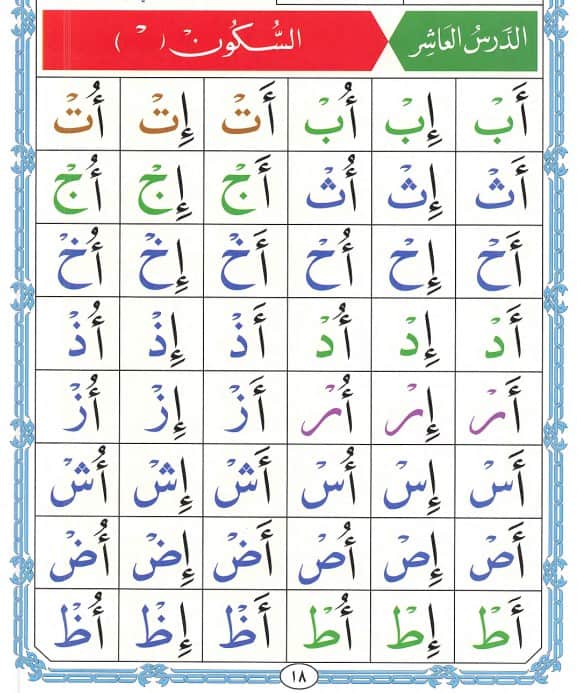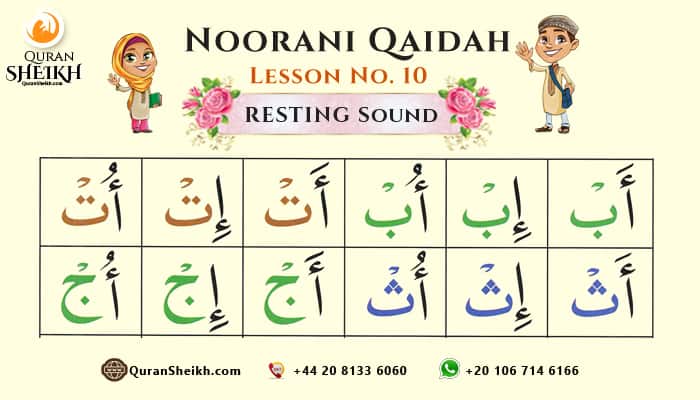Noorani Qaida Lesson 10: Master Sukoon for Clear Quranic Pauses
Noorani Qaida lesson 10: In this chapter of the Resting sound, we have five special letters. When one comes to this lesson, one should know about these five letters. These letters are:
ق ، ط ، ب ، ج ، د
In a combined form these letters are written as قُطبَ جَد and these letters are called as “HUROOF UL QALQALA”. These are the only letters that produce the bouncing or echo sounds. Remember that other letters except these don’t have echo sounds.
In reality, if these letters are not pronounced correctly then you cannot tell what letter actually has been pronounced.
For these letters, you must push the sound outside the mouth. If the letter has sukoon then pronounce that sound without moving it as sukoon is opposite to harakah.
Harakah means to move the sound to the direction of fathah, kasrah or dammah. When the harakat is taken away, they are replaced by a sukoon which is a resting sound. If the above five letters come with sukoon, they produce a bouncing sound.
There is one rule about sukoon letters and that is they cannot read by itself. They always need harakah before it in order to pronounce. That’s why in this lesson all the sukoon letters have fathah, kasrah and dammah before them.
The second type of letters discussed in this lesson are SOFT LETTERS which are the opposite of QALQALA letters.
These letters are called as ھمس letters and are:
س ، ک ، ت ، ف ، ح ، ث ، ھ ، ش ، خ ، ص
In a group form these are written as:
سَکَتَ فحثّہُ شَخصٌ
When these letters are pronounced, air must come out from the mouth.
Here ک and ت are special letters. When pronouncing ت it is necessary to spit out the sound and for ک it is necessary to pronounce coughing sound.
خ and ر letters are also special letters. As you know both are heavy letters but if they have sukoon and also kasrah before it then these letters become light. So, they are pronounced as light letters.
Noorani Qaida Lesson 10 Video:
Learn Sukoon rules with Noorani Qaida Lesson 10. Master resting sounds, Qalqalah, and soft letters for clear Quranic pauses. Start today!
Join thousands of Muslim Families who love learning Noorani Qaida & Quran reading from the comfort of their Homes.
Noorani Qaida lesson 10
Noorani Qaida Page 18

أَبۡ: read it as “ھمزہ فتحہ ب ءَب” (hamzah fathah ba aubbe).
إِبۡ: read it as “ھمزہ کسرہ ب ءِب” (hamzah kasrah ba ibbe).
أُبۡ: read it as “ھمزہ کسرہ ب ءُب” (hamzah kasrah ba ubbe).
Pronouncing together as:
ءَب ، ءِب ، ءُب (abbe, ibbe, ubbe).
أُتۡ: read it as “ھمزہ فتحہ ت ءَت” (hamzah fathah ta atte).
إِتۡ: read it as “ھمزہ کسرہ ت ءِت” (hamzah kasrah ta itte).
أُتۡ: read it as “ھمزہ ضممہ ت ءُت” (hamzah dammah ta utte).
Pronouncing together as:
ءَت ، ءِت ، ءُت (atte, itte, utte).
Precaution: try to produce spitting sound because ت comes from the upper teeth so when you make a sukoon on it, you must produce spitting sound.
أَثۡ: read it as “ھمزہ فتحہ ث ءَث” (hamzah fathah sa asse).
إِثۡ: read it as “ھمزہ کسرہ ث ءِث” (hamzah kasrah sa isse).
أُثۡ: read it as “ھمزہ ضممہ ث ءُث” (hamzah dammah sa usse).
Pronouncing together as:
ءَث ، ءِث ، ءُث (asse, isse, usse).
أَجۡ: read it as “ھمزہ فتحہ ج ءَج” (hamzah fathah jeem ajje).
إِجۡ: read it as “ھمزہ کسرہ ج ءِج” (hamzah kasrah jeem ijje).
أُجۡ: read it as “ھمزہ ضممہ ج ءُج” (hamzah dammah jeem ujje).
Pronouncing together as:
ءَج ، ءِج ، ءُج (ajje, ijje, ujje).
أَخۡ: read it as “ھمزہ فتحہ ح ءَح” (hamzah fathah ha ahhe).
إِخۡ: read it as “ھمزہ کسرہ ح ءِح” (hamzah kasrah ha ihhe).
أُخۡ: read it as “ھمزہ ضممہ ح ءُح” (hamzah dammah ha uhhe).
Pronouncing together as:
ءَح ، ءِح ، ءُح (ahhe, ihhe, uhhe).
Learn Quran Online fast and easy with a Qualifies Arab teacher, Get 30% OFF join now.
أَخۡ: read it as “ھمزہ فتحہ خ ءَخ” (hamzah fathah kha akhkhe).
إِخۡ: read it as “ھمزہ کسرہ خ ءِخ” (hamzah kasrah kha ikhkhe).
أُخۡ: read it as “ھمزہ ضممہ خ ءُخ” (hamzah dammah kha ukhkhe).
Pronouncing together as:
ءَخ ، ءِخ ، ءُخ (akhkhe, ikhkhe, ukhkhe).
أُدۡ: read it as “ھمزہ فتحہ دال ءَد” (hamzah fathah dal adde).
إِدۡ: read it as “ھمزہ کسرہ دال ءِد” (hamzah kasrah dal idde).
أُدۡ: read it as “ھمزہ ضممہ دال ءُد” (hamzah dammah dal udde).
Pronouncing together as:
ءَد ، ءِد ، ءُد (adde, idde, udde).
أُذۡ: read it as “ھمزہ فتحہ ذال ءَذ” (hamzah fathah zal azze).
إِذۡ: read it as “ھمزہ کسرہ ذال ءِذ” (hamzah kasrah zal izze).
أُذۡ: read it as “ھمزہ ضممہ ذال ءُذ” (hamzah dammah zal uzze).
Pronouncing together as:
ءَذ ، ءِذ ، ءُذ (azze, izze, uzze).
أُرۡ : read it as “ھمزہ فتحہ ر ءَر” (hamzah fathah ra are).
إِرۡ: read it as “ھمزہ کسرہ ر ءِر” (hamzah kasrah ra irre).
أُرۡ: read it as “ھمزہ ضممہ ر ءُر” (hamzah dammah ra urre).
Pronouncing together as:
ءَر ، ءِر ، ءُر (arre, irre, urre).
أُزۡ: read it as “ھمزہ فتحہ ز ءَز” (hamzah fathah za azze).
إِزۡ: read it as “ھمزہ کسرہ ز ءِز” (hamzah kasrah za izze).
أُزۡ: read it as “ھمزہ ضممہ ز ءُز” (hamzah dammah za uzze).
Pronouncing together as:
ءزَ ، ءِز ، ءُز (azze, izze, uzze).
أُسۡ: read it as “ھمزہ فتحہ س ءَس” (hamzah fathah seen asse).
إِسۡ: read it as “ھمزہ کسرہ س ءِس” (hamzah kasrah seen isse).
أُسۡ: read it as “ھمزہ ضممہ س ءُس” (hamzah dammah seen usse).
Pronouncing together as:
ءَس ، ءِس ، ءُس (ase, ise, use).
أُشۡ: read it as “ھمزہ فتحہ ش ءَش” (hamzah fathah sheen ashe).
إِشۡ: read it as “ھمزہ کسرہ ش ءِش” (hamzah kasrah sheen ishe).
أُشۡ: read it as “ھمزہ ضممہ ش ءُش” (hamzah dammah sheen ushe).
Pronouncing together as:
ءَش ، ءِش ، ءُش (ashe, ishe, ushe).
أُصۡ: read it as “ھمزہ فتحہ ص ءَص” (hamzah fathah Saad asse).
إِصۡ: read it as “ھمزہ کسرہ ص ءِص” (hamzah kasrah Saad isse).
أُصۡ: read it as “ھمزہ ضممہ ص ءُص” (hamzah dammah Saad usse).
Pronouncing together as:
ءَص ، ءِص ، ءُص (asse, isse, usse).
أُضۡ: read it as “ھمزہ فتحہ ض ءَض” (hamzah fathah Zad aZze).
إِضۡ: read it as “ھمزہ کسرہ ض ءِض” (hamzah kasrah Zad iZze).
أُضۡ: read it as “ھمزہ ضممہ ض ءُض” (hamzah dammah Zad uZze).
Pronouncing together as:
ءَض ، ءِض ، ءُض (aZze, iZze, uZze).
أُطۡ: read it as “ھمزہ فتحہ ط ءَط” (hamzah fathah Ta atte).
إِطۡ: read it as “ھمزہ کسرہ ط ءِط” (hamzah kasrah Ta itte).
أُطۡ: read it as “ھمزہ ضممہ ط ءُط” (hamzah dammah Ta utte).
Pronouncing together as:
ءَط ، ءِط ، ءُط (atte, itte, utte).
أُظۡ: read it as “ھمزہ فتحہ ظ ءَظ” (hamzah fathah Za aZze).
إِظۡ: read it as “ھمزہ کسرہ ظ ءِظ” (hamzah kasrah Za iZze).
أُظۡ: read it as “ھمزہ ضممہ ظ ءُظ” (hamzah dammah Za uZze).
Pronouncing together as:
ءَظ ، ءِظ ، ءُظ (aZze, iZze, uZze).
Noorani Qaida PDF:
Download Noorani Qaida Book as a PDF file, please click on download icon.
Noorani Qaida Online Course:
Quran Sheikh Institute provide you Noorani Qaida course Register now and get 25% OFF.
Start noorani qaida lessons and know how to read Arabic Alphabet up to read Quran with Tajweed insha Allah well.
Learn Quran for Kids & Adults – From Beginner to Fluent
Free Trial Lesson – Sign Up Today

FAQs about Noorani Qaida Lesson 10 – Sukoon Rules
What is Sukoon in Quranic Arabic?
Sukoon (ـْ) is a “resting sound” symbol in Arabic that indicates a letter has no vowel (fatha, kasra, or damma). It requires a slight bounce or echo when pronounced, especially with Qalqalah letters (ق, ط, ب, ج, د).
Which letters require Qalqalah (echo) sounds in Sukoon?
The 5 Qalqalah letters are ق, ط, ب, ج, د (combined as “قُطبَ جَد”). These must produce a bouncing sound when they have Sukoon. Example: أَبۡ (abbe) emphasizes the “b” bounce.
How do you pronounce soft letters with Sukoon?
Soft letters (س, ک, ت, ف, ح, ث, ھ, ش, خ, ص) require airflow when pronounced with Sukoon. For example:
✔️ تۡ: Spit the sound gently (e.g., أُتۡ → “utte”).
✔️ کۡ: Add a light coughing sound (e.g., أَکۡ → “akke”).
What’s the difference between Qalqalah and soft letters?
Qalqalah letters create an echo on Sukoon, while soft letters focus on airflow. For example:
✔️ قۡ (Qalqalah): Pronounce “aqq” with a throat bounce.
✔️ سۡ (Soft): Say “asse” with a hissing “s”.
Why do خ and ر change weight with Sukoon?
Though usually “heavy” letters, خ and ر become light if they have Sukoon and a kasrah (ـِ) before them. Example: إِرۡ (irre) is lighter than أَرۡ (arre).
How to practice Sukoon rules effectively?
✔️ Use the “rest-pause” method: Hold Sukoon letters for 1–2 seconds (e.g., أُدۡ → “udde”).
✔️ Watch video tutorials for Qalqalah echo and soft letter airflow.
What are common mistakes in Sukoon pronunciation?
✔️ Skipping the echo in Qalqalah letters (e.g., pronouncing أَجۡ as “aj” instead of “ajje”).
✔️ Ignoring airflow in soft letters (e.g., saying أَثۡ as “ath” instead of “asse”).
Sukoon (ـْ) is a vital symbol in Arabic, indicating a letter with no vowel sound. Mastering Sukoon unlocks proper pauses and clear pronunciation in Quranic reading. This lesson reveals how to pronounce Sukoon letters, Qalqalah, and soft letters effectively.
How to pronounce a letter with Sukoon (ـْ)?
A letter with Sukoon has no vowel sound (Fathah, Kasrah, or Dammah). Give it a quick, “resting” sound. It needs a preceding vowel to be pronounced.
How to create the Qalqalah (echo) sound?
Only five letters (ق ط ب ج د) have a Qalqalah. Vibrate or bounce the sound when these letters have Sukoon. Example: أَبۡ = “abbe” (emphasize the “b” bounce).
How to pronounce “soft letters” with Sukoon?
Some letters (س ک ت ف ح ث ھ ش خ ص) require a gentle airflow when pronounced with Sukoon. Practice spitting the sound gently for “Taa” and adding a slight coughing sound for “Kaaf”.
How to differentiate between Qalqalah and Soft letters?
Qalqalah letters create an echoing bounce with Sukoon, while soft letters rely on airflow.
How to practice Sukoon effectively?
Use the “rest-pause” method: Briefly hold Sukoon letters (1-2 seconds). Listen to audio examples from a qualified teacher and pay close attention to the subtleties of Qalqalah and soft letter pronunciation.
Explore Previous Lesson:
Tanween, Madd & Lin Exercises
Noorani Qaida Lesson 9
Master the Next Step:
Sukoon Mastery Exercises





